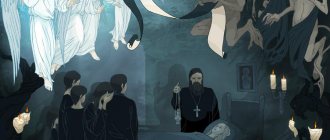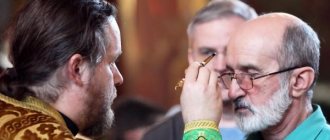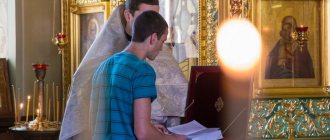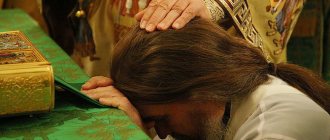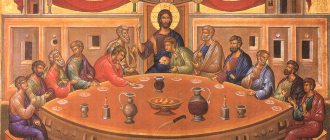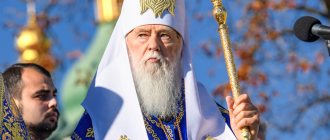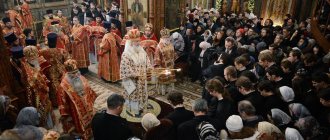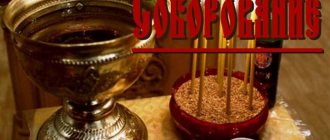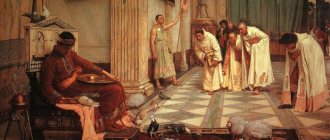Sacrament of Priesthood
The word “ordination” is of Greek origin and is translated as “ordination.” In antiquity, this was the name given to the voting procedure by show of hands when electing government officials. The term was borrowed by the Church and over time lost its original secular meaning. Ordination - what is it in Orthodoxy? This is a Church Sacrament, which consists of ordaining a Christian to the clergy, that is, to one of the degrees of the priesthood.
Ordination - transfer of grace through ordination
Concept of celibacy
The vow of celibacy for men is typical for clergy of the Catholic Church. In Orthodoxy, deacons and priests have the right to start a family. Bishops are prohibited from having a wife. In this case, the highest rank is given to monks. If celibacy is not connected with monasticism, then for ordination as a bishop one must:
- have higher education;
- undergo an internship in a monastery or large parish for 2 years;
- receive recommendations from a confessor, the rector of a religious educational institution, or the priest of the parish where you completed your internship.
The severity of the test for those who live a worldly life and do not marry is related to the temptations surrounding the candidate.
Ordination - what is it in Orthodoxy?
In Orthodoxy, there are three degrees of priesthood: diakonia, presbytery (priest, priest) and episcopate (bishop). Consecration into each of them is carried out according to a special rite. However, they are all performed by the bishop, with the laying on of his hands on the dedicatee. In this way, the person supplied is given special grace (a gift from God) for serving the Church. People are always ordained at the Divine Liturgy, in the altar. Archpriest Gennady Nefedov explains that ordination is a Sacrament in which the chosen one receives the grace of the priesthood through the power of the congregational prayer of the Church.
The Apostles of Christ were endowed with the fullness of priestly ministry. They inherited the corresponding grace from the Lord Himself when the Holy Spirit descended on them on the 50th day after the Resurrection of the Savior. The disciples of Jesus Christ passed on this Divine gift to other Christians through their ordination as bishops. They, in turn, supplied new bishops.
Thus, bishops are the successors of the apostles and the agents of their grace. This sacred connection is expressed in a special church term - “apostolic succession.” It is she who ensures the canonical status of Orthodox clergy. Therefore, violation of canonical ties with the legitimate Hierarchy is a departure from the Lord and deprives of grace. Metropolitan Hilarion (Alfeev) answers the question “ordination – what is it?”:
“If the sacrament of the Priesthood is a triumph in the life of the entire Church, then for the one being initiated it is his personal Pentecost, when the Holy Spirit descends on him and he receives many grace-filled gifts.”
Ordination to the diaconate
Deacons are made by those who are already serving in the church, but are at one of the initial, non-priestly levels of the church hierarchy. These are called clergy or junior clerics. These include readers and subdeacons. The latter are the bishop's assistants at bishop's services. Subdeacons prepare vestments, serve church utensils, and open the royal doors (the central doors of the iconostasis).
The ordination of a Christian as a deacon gives him the right to assist the priest at divine services and in conducting the Church Sacraments. A deacon cannot perform sacred rites independently. The installation is performed by one bishop at the Divine Liturgy of any order. According to the Clergyman's Handbook:
“Ordination to the diaconate takes place at the liturgy after the consecration of the Holy Gifts, namely after the bishop utters the exclamation: “And may the mercies of the Great God and our Savior Jesus Christ be with you all.”
The initiate is led around the throne three times. At the same time, the future deacon kisses its corners, and then bows his head on it, standing on his right knee. The bishop places his omophorion (part of the vestment) and both hands on the head of the person supplied. This marks the laying on of the hands of Christ himself, who invisibly participates in the Sacrament. The bishop reads a special prayer, calling upon the protege the grace-filled gifts of the Holy Spirit.
Ordination is a sacred rite that also includes presenting the newly initiated with attributes corresponding to his new rank. The deacon is given a robe, an orarion (items of vestment) and a ripida (item of liturgical utensils). Each presentation is accompanied by exclamations from the bishop and other clergy “Axios!” (“Worthy!”).
Instructions of St. Gregory Dvoeslov to spiritual shepherds
The shepherd who rules the spiritual flock of Christ must be a leading example for him in all his deeds, so that with his very life he shows his flock the path of life, and his verbal flock, following the voice and deeds of his shepherd, learns and improves more from example than from his words. For if the height of the place he occupies calls for a corresponding elevation of words, then the same height also requires high feats. Moreover, the oral sermon itself penetrates more conveniently and truly into the hearts of the listeners when the words of the preacher are confirmed by his exemplary life: with a word he only convinces and motivates to action, and by example he helps and participates in action. “Come up to a high mountain, preaching the good news to Zion ,” says the Lord through the prophet (Is. 40:9), thereby instilling that the one preaching about heavenly things should rise above the level of earthly affairs and, as it were, stand in the most prominent place, so that it would be more convenient for him to attract listeners his own and raise them to perfection, the louder the voice of his holy life is heard from above.
The shepherd who rules over the spiritual flock of Christ must be discerning both in silence and in words, so as not to speak about what should be silent, and not to remain silent about what should be spoken about. For just as rash speech can mislead listeners, so inappropriate silence can leave them also in error; whereas in both cases, with the prudent discernment of the leading shepherd, they could get rid of it. Meanwhile, it often happens that unreasonable and improvident shepherds, for fear of losing the favor of their flock, are afraid and do not dare to freely express the truth; but these are no longer good shepherds who lay down their souls for the sheep, according to the words of Truth itself, but mercenaries who, as it were, run at the sight of the coming wolf , when they take refuge under the pretext of silence (cf. John 10: 11-13). The Lord speaks reproachfully about them through the prophet: the dogs will not be able to bark at them (Ex. 56:10); and in another place: You did not stand in the firmament, nor set up a wall against the house of Israel, nor resisted in battle on the day of the Lord (Ezek. 13:5). To stand on the firmament means to freely and fearlessly defend the spiritual flock from all attacks and oppressions of this world, and resisting in battle on the day of the Lord - to fight out of love for righteousness with every sinner, no matter who he is, despite any his resistance and opposition.
But to be afraid to speak the truth because of anything, and to hide behind silence—isn’t it the same for a shepherd as for a military leader to flee from the battlefield without any struggle? The prophet Jeremiah also speaks about such unworthy shepherds: The priests do not say: where is the Lord? ...And your shepherds were dishonest against Me, and your prophets prophesied in Baal, and you followed idols (Jer. 2:8). Sometimes in the Holy Scriptures teachers are also called prophets, for whom all prophecy is limited to the fact that, showing the corruption of the present, they inspire hope for the future. The Word of God reproaches them for indulging in the vanity of the people, which they clearly see, but do not want or are afraid to point it out to the sinners themselves, lulling only their conscience with their caresses. They do not dare to be denouncers of their subordinates, lest they immediately expose themselves, while pastoral reproof serves as the most effective means for admonishing and correcting even hardened sinners: for, listening to the prudent reproofs of their spiritual father, who convicts them with pastoral authority, they with contrition of heart and repentance they confess their sins, often even those that were a secret to themselves.
If the shepherd stands with his chest, then he puts up a barrier to the enemy and is a stronghold for the flock of the house of Israel. Anyone who enters into pastoral ministry takes upon himself the responsibility of being a spiritual herald and speaking before the people with a loud trumpet in order to prepare them for the meeting of the Supreme Judge on the Day of the Last Judgment. But if the shepherd is not strong in words, and remains silent before his flock, then which of him, the silent one, can be the herald and herald of the glory of God? For this reason, the Holy Spirit descended on our first Christian shepherds (apostles) in the form of tongues of fire ; and as soon as they were filled with the Spirit , they immediately began to preach (Acts 2:2-4) (“Pastoral Rule”, selected excerpts, desk calendar of the Russian Orthodox Church of the Caucasus-Don Diocese, 2014).
Ordination to presbyter (priest)
Only a Christian who has been elevated to the rank of deacon can become a priest. An ordained priest is a representative of the bishop and, on his instructions, performs divine services and the Sacraments. However, the presbyter cannot conduct ordinations, that is, transfer to other Christians the grace of the priesthood received.
Ordination to the priesthood is performed by one bishop at the Liturgy of St. John Chrysostom or St. Basil the Great. After all, the newly ordained presbyter must take part in the main part of this service - the Eucharistic canon. It is absent from the Liturgy of the Presanctified Gifts, so ordination to the priesthood is impossible there.
“Ordination to the priesthood takes place after the transfer of the Honorable Gifts from the altar to the throne, after the singing of the Cherubic Song, so that the ordained one can participate in the consecration of the Gifts” (“Handbook of the Clergyman”).
The ordination takes place in a similar way to the deacon's ordination: with a three-time circumambulation of the altar, kneeling, laying on of hands by the bishop, reading a special prayer, and presentation of sacred attributes. However, there are some differences. For example, a priest kneels before the throne not on one, but on two knees. Of course, the text of the bishop’s prayer is also different.
The newly ordained priest is given such items of vestment as an epitrachelion, a belt, a phelonion and a pectoral (breast) cross. The “Servant Book” is also presented - according to this book, the appointed priest at the end of the liturgy reads the prayer behind the pulpit.
Who can be ordained
Climbing up the church hierarchical ladder is available to those who have:
- lower ecclesiastical positions;
- age from 18 to 30 years;
- secondary education;
- healthy psyche, physical strength;
- recommendation from an Orthodox priest.
A deacon and a priest can be married, but it is better for a bishop to become a monk and take a vow of celibacy. In exceptional cases, marriage is allowed if the wife agrees to become a nun. The requirements for the wives and children of a priest are strict. The priest's family should be an example in behavior for the flock.
Bishop's consecration
What is consecration as a bishop? Monastic presbyters, namely archimandrites, are appointed to this highest degree of priesthood. According to the 1st Apostolic Canon, this rite can only be carried out by a “council of bishops,” that is, at least two bishops. The ordained person is endowed with the fullness of priestly ministry. He can pass it on to other Christians, performing ordinations, and consecrate churches. Metropolitan Hilarion (Alfeev) notes:
“The consecration of a bishop is distinguished by its special solemnity: it is preceded by the rite of naming, when the consecrated person pronounces an oath and confession of faith.”
Ordination takes place at the Liturgy of St. John Chrysostom or St. Basil the Great after the singing of “Holy God,” before the reading of the Apostle. The initiate bows two knees before the throne. The revealed Gospel and the hands of all the bishops present are placed on the one delivered. Special prayers are read in which the Lord is asked for the newly initiated to become a worthy “imitator of the true Shepherd,” that is, Jesus Christ.
The ordained bishop is given the following items of vestment: sakkos, omophorion, cross, miter (headdress) and panagia (breastplate of the Mother of God). After the liturgy, they give a rosary and a staff - a symbol of pastoral power. The newly ordained bishop accepts the holy cup at the Great Entrance and administers it during the communion of the Holy Mysteries of Christ. At the end of the service, he blesses the worshippers.
Clergy vestments
The clergy, during their initiation, and then during Divine services in general, put on sacred robes. The deacon puts on a surplice, ular (orarion) and brim. The priest wears a vestment (the same surplice), an epitrachelion (a thick ular), a belt, brace and chasuble (or phelonion). The bishop dresses in the same clothes as the priest, but instead of the epitrachelion, the bishop puts on a special garment called an amphora (omophorion) - this is a long wide ribbon placed on the bishop’s shoulders so that one end of it goes down in front and the other in the back. Instead of a phelonion, metropolitans and archbishops wear a sakkos - clothing similar to a short surplice with short sleeves. The miter is the head adornment of bishops; panagia - a small round image of the Savior or the Mother of God, richly decorated, which bishops wear on their chests, like a cross. A staff or rod is a sign of episcopal authority. During the service, at certain moments, the bishop stands on special round rugs - orlets, on which, according to the name, an eagle is depicted flying over the city. This means that the bishop, through his teaching and his life, must rise above his flock and serve as an example for them of striving from the earthly to the heavenly, like an eagle soaring in the air.
